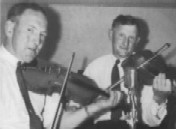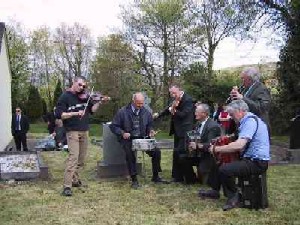![]() Paddy & Patrick Joseph
Paddy & Patrick Joseph
 Paddy was born in 1919 in Glendree, a townland in the parish of Tulla nestled beneath the Sliabh Aughty mountains of east County Clare. He was one of three sons of Pat and his wife, the former Catherine MacNamara of nearby Feakle. The elder Pat was a farmer, fiddler and flute player who taught music to local youngsters. Paddy also picked up a lot of music from Pat McNamara, a blind fiddler from Cooleen Bridge who lodged with them for several years during the winter months. Another important influence was Martin Nugent, a fiddler who encouraged Paddy to join him in playing for dances at Paddy's uncle's house in Feakle. Paddy's passion for music often led him to take the fiddle to the fields in order to get in a bit of practice during the workday. He also learned to read music with help from his friend Martin Rochford, a fiddler and uilleann piper who transcribed tunes for him from a precious copy of Francis O'Neill's Dance Music of Ireland. In 1946, Paddy became a founder member of the Tulla Ceili Band, a group that would become the most celebrated dance ensemble in the history of Irish traditional music. He played with the Tulla band for two decades, years that included a famous and friendly cross-county rivalry with the Kilfenora Ceili Band and triumphal performances in England and America. At the 1953 fleadh cheoil in Athlone, Paddy added to his already lustrous reputation by winning the senior All-Ireland fiddle championship. A trip to New York in 1956 with fiddler and politician Dr Bill Loughnane led to a solo performance at Carnegie Hall. Paddy frequently took the train up to Dublin in the late 1950s to make live broadcasts on Radio Eireann, performances for which he was paid two or three pounds plus expenses. A recording of his rendition of the reel Trim the Velvet served as theme music for Ciaran MacMathuna's popular Ceolta Tire program. In this Paddy also recorded 78 rpm discs for Gael Linn. In 1961, Paddy married Philomena, a sister of Patrick Joseph, but continued to maintain a demanding schedule of farming and fiddling. In 1966, however, he decided to leave the Tulla Ceili Band. 'Too much travelling in bad cars on bad roads,' he says, adding that 'the cows had to be milked twice daily - that cut out the music'. Paddy made several television broadcasts for RTE in the 1960s, but largely retreated from public performances. In 1991, he launched something of a comeback when he journeyed to Paris for a festival performance with Peadar O'Loughlin and concertina player Paddy Murphy. In 1997, he released a long-overdue solo recording for Clo Iar-Chonnachta. Paddy continues to do a bit of work on the farm and, of course, to play the fiddle. 'If you can't play a tune', he says, 'life is not worth living'.
Paddy was born in 1919 in Glendree, a townland in the parish of Tulla nestled beneath the Sliabh Aughty mountains of east County Clare. He was one of three sons of Pat and his wife, the former Catherine MacNamara of nearby Feakle. The elder Pat was a farmer, fiddler and flute player who taught music to local youngsters. Paddy also picked up a lot of music from Pat McNamara, a blind fiddler from Cooleen Bridge who lodged with them for several years during the winter months. Another important influence was Martin Nugent, a fiddler who encouraged Paddy to join him in playing for dances at Paddy's uncle's house in Feakle. Paddy's passion for music often led him to take the fiddle to the fields in order to get in a bit of practice during the workday. He also learned to read music with help from his friend Martin Rochford, a fiddler and uilleann piper who transcribed tunes for him from a precious copy of Francis O'Neill's Dance Music of Ireland. In 1946, Paddy became a founder member of the Tulla Ceili Band, a group that would become the most celebrated dance ensemble in the history of Irish traditional music. He played with the Tulla band for two decades, years that included a famous and friendly cross-county rivalry with the Kilfenora Ceili Band and triumphal performances in England and America. At the 1953 fleadh cheoil in Athlone, Paddy added to his already lustrous reputation by winning the senior All-Ireland fiddle championship. A trip to New York in 1956 with fiddler and politician Dr Bill Loughnane led to a solo performance at Carnegie Hall. Paddy frequently took the train up to Dublin in the late 1950s to make live broadcasts on Radio Eireann, performances for which he was paid two or three pounds plus expenses. A recording of his rendition of the reel Trim the Velvet served as theme music for Ciaran MacMathuna's popular Ceolta Tire program. In this Paddy also recorded 78 rpm discs for Gael Linn. In 1961, Paddy married Philomena, a sister of Patrick Joseph, but continued to maintain a demanding schedule of farming and fiddling. In 1966, however, he decided to leave the Tulla Ceili Band. 'Too much travelling in bad cars on bad roads,' he says, adding that 'the cows had to be milked twice daily - that cut out the music'. Paddy made several television broadcasts for RTE in the 1960s, but largely retreated from public performances. In 1991, he launched something of a comeback when he journeyed to Paris for a festival performance with Peadar O'Loughlin and concertina player Paddy Murphy. In 1997, he released a long-overdue solo recording for Clo Iar-Chonnachta. Paddy continues to do a bit of work on the farm and, of course, to play the fiddle. 'If you can't play a tune', he says, 'life is not worth living'.
 Patrick Joseph was born in 1921 in Maghera, Caher, County Clare. He started to play the fiddle at the age of 11 or 12, learning his first tunes from his friend Paddy, who would put the notes on paper by writing A, B. C, etc. on lines indicating the four strings of the fiddle. As a young fiddler, Patrick Joseph drew inspiration from the style and repertoire of such local musicians as John Naughton, Joe Bane and Pat (Paddy's father). Like most musicians in Ireland in those years, however, both he and Paddy also learned a lot of music from the 78 rpm discs recorded by such famed fiddlers as Michael Coleman, Hughie Gillespie and Paddy Killoran. Patrick Joseph also remembered being impressed by recordings by the Flanagan Brothers, a popular accordion-and-banjo duo, and by County Meath fiddler Frank O'Higgins. The first gramophone in his household was shipped from America by one of his aunts when Patrick Joseph was nine years old. 'It was a huge big box like a coffin', he later told Irish Music magazine, adding that the first record his father put on was a speech by De Valera. 'The speech was only half-way through when the spring broke and he had to go to Limerick the next morning to get a new spring for it'. In the 1930s and 40s, Patrick Joseph played for house dances, parties for 'returned Yanks' and at annual parties paid for by the receipts from 'hunting the wren' on St. Stephen's Day. In an interview with Fiddler magazine, he recalled that as many as ninety people might assemble for one of these house dances. 'Nobody ever said they couldn't hear even when there was no amplification', he remarked, 'and now we can hardly hear with the amplification, so there's something wrong someplace'. Together with Paddy, Patrick Joseph joined the Tulla Ceili Band, and he assumed the leadership of the group in 1952. In those days, the band often had as many as 100 bookings a year, but everyone still had to get home in time to milk the cows. Before each dance, a meal was provided for the band members. 'After the dance, they'd be trying to make a bargain with you', he later told the Irish Times, 'and you'd have no sympathy for them if the tea wasn't good'. Patrick Joseph led the Tulla Ceili Band to All-Ireland championships in 1957 and 1960. In addition to several recordings with the band, he also made an album called The Shores of Lough Graney with his son Martin, a fiddler now even more famous internationally than his father. In 1997, the Tulla Ceili Band celebrated their fiftieth anniversary by making a new recording and winning the National Entertainment Award. Patrick Joseph himself was named 'Clareman of the Year'. Musically active until just before his death, Patrick Joseph passed away at his home in Maghera on May 6, 2001.
Patrick Joseph was born in 1921 in Maghera, Caher, County Clare. He started to play the fiddle at the age of 11 or 12, learning his first tunes from his friend Paddy, who would put the notes on paper by writing A, B. C, etc. on lines indicating the four strings of the fiddle. As a young fiddler, Patrick Joseph drew inspiration from the style and repertoire of such local musicians as John Naughton, Joe Bane and Pat (Paddy's father). Like most musicians in Ireland in those years, however, both he and Paddy also learned a lot of music from the 78 rpm discs recorded by such famed fiddlers as Michael Coleman, Hughie Gillespie and Paddy Killoran. Patrick Joseph also remembered being impressed by recordings by the Flanagan Brothers, a popular accordion-and-banjo duo, and by County Meath fiddler Frank O'Higgins. The first gramophone in his household was shipped from America by one of his aunts when Patrick Joseph was nine years old. 'It was a huge big box like a coffin', he later told Irish Music magazine, adding that the first record his father put on was a speech by De Valera. 'The speech was only half-way through when the spring broke and he had to go to Limerick the next morning to get a new spring for it'. In the 1930s and 40s, Patrick Joseph played for house dances, parties for 'returned Yanks' and at annual parties paid for by the receipts from 'hunting the wren' on St. Stephen's Day. In an interview with Fiddler magazine, he recalled that as many as ninety people might assemble for one of these house dances. 'Nobody ever said they couldn't hear even when there was no amplification', he remarked, 'and now we can hardly hear with the amplification, so there's something wrong someplace'. Together with Paddy, Patrick Joseph joined the Tulla Ceili Band, and he assumed the leadership of the group in 1952. In those days, the band often had as many as 100 bookings a year, but everyone still had to get home in time to milk the cows. Before each dance, a meal was provided for the band members. 'After the dance, they'd be trying to make a bargain with you', he later told the Irish Times, 'and you'd have no sympathy for them if the tea wasn't good'. Patrick Joseph led the Tulla Ceili Band to All-Ireland championships in 1957 and 1960. In addition to several recordings with the band, he also made an album called The Shores of Lough Graney with his son Martin, a fiddler now even more famous internationally than his father. In 1997, the Tulla Ceili Band celebrated their fiftieth anniversary by making a new recording and winning the National Entertainment Award. Patrick Joseph himself was named 'Clareman of the Year'. Musically active until just before his death, Patrick Joseph passed away at his home in Maghera on May 6, 2001.
![]()